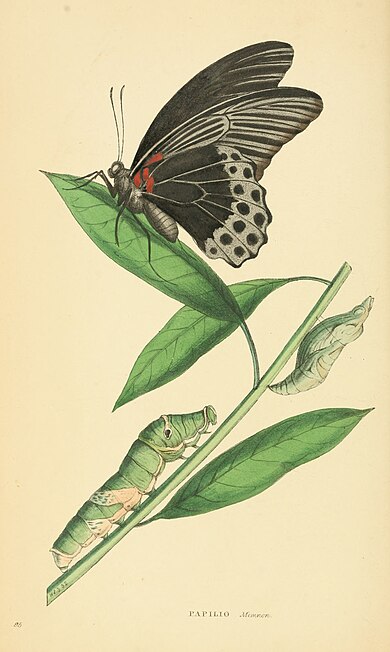PAPILIO Memnon.
Although of sombre colours, this butterfly is imposing in its size, and highly interesting. It is, in fact, that form which is pre-eminently typical of the whole of the Latriellian Papilionidæ. It seems to be common throughout India and particularly so in Java, from whence we possess several specimens. Dr. Horsfield's elaborate work has furnished us with figures of the caterpillar and chrysalis.
PAPILIO Memnon,
Memnon Butterfly.
Fam. Papilionidæ. Sub-Fam. Papilionæ. Genus Papilio.—Sw.
(Typical form or Sub-genus.)
Sub-Generic Characters.
Wings without tails; the anterior horizontally lengthened, entire; the posterior margin concave; posterior wings perpendicularly lengthened, the margin rounded and scolloped; antennæ long. Larva smooth; Pupa braced in an erect position.
Sub-Types of form. 1. Typical, Memnon. 2. Sub-typical, Erectheus. 3. Aberrant, Pammon, Drusius? Codrus.
Specific Character.
Wings black, rayed with blue-grey; inferior wings beneath with two rows of marginal black spots on a pale ground, and four red spots at the base.
Papilio Memnon, Linn. Auct. Ency. Meth. 1. p. 29. No. 10. Cramer, pl. 91. f. c.
In now first defining some of the natural groups of the modern Genus Papilio, it may be as well to state that we give the results of minute analysis, the details of which we hope to lay before the public on a future occasion. In regard to the nomenclature, we have adopted the following principles, suggested to us by a scientific friend of no ordinary authority, as tending to facilitate recollection, without altering well known specific names. Each genus or sub-genus will be named after that species which is its peculiar type; and the new specific name of this species will imply one of its supposed natural analogies. Thus the sub-genus Protesilaus, derives its name from the typical species, while the specific name, now proposed of Leilus, points out the analogy of the group to Urania Fab. The sub-genus we now define, as being in our estimation, pre-eminently typical, retains the name of the genus. It seems also a geographic group, since all the species yet discovered belong to the old world.
